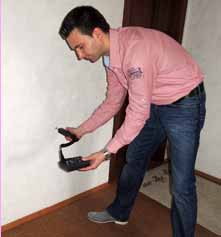Recently made in the press a report circulating that many mold remediation are not conducted properly. “Three quarters of the architect, building surveyor, construction and renovation contractor and lawyers assume that 70 percent of the renovations are flawed,” reported the director of the Institute Peridomus Dr. Gerhard Führer from Himmelstadt/Germany. Even if there should be ten or twenty percent fewer cases, the incidence of improper renovations would be a disaster for the affected residents. So-called “brush renovations” mean nothing else than that the moisture damage was simply painted over. The new tenant sees the problem not at first attempt and the landlord has his first sleep.
Main problem: the cause is not gone to the bottom
Mold colonization in the apartment is almost exclusively the result of a moisture problem. This in turn can have x times causes. The most common of these are a hidden water damage from leaking pipes or a leaky building envelope and condensation precipitation due to high relative humidity combined with thermal bridges in building construction. The assignment, whether a construction defect is present or an unmatched user behavior is regularly a topic of debate. In practice it is often present a complex link between the two causes. The appointed expert usually has suitable equipment to move the moisture problem on the reason: wall moisture analyzers, data loggers for the indoor environment, measuring instruments for the surface temperature or thermal imaging cameras. The question remains why the cause of research is still not carried out.
In the cost trap
The moisture damage repair can go tremendously expensive. For example, if the insulation soaked under the screed due to water damage, the entire floor structure must be replaced if necessary. Turns out that the mold was caused by thermal bridges in building construction, possibly a complete insulation system is necessary. Particularly noisy , the affected tenants or owners should be if an insured event has occurred. The regulator usually brings in its “own” expert and decides in doubt for the “low-budget” restoration. An example: As a result of water damage in the bathroom show up at the adjacent plasterboard wall mold stains. The payer instructs the remediation company to remove the mold and dry the wall. An examination of the floor structure does not occur. Thus, the visible problem is first solved. The insurance carries himself with the hope that even nothing will happen and you can extricate yourself if necessary.
New tenants, new luck
Low-cost remediation is also applied to landlords page again and again: the painter removed the mold and sweeps with wall paint over the formerly contaminated area. The cause of the mold colonization is not investigated. In addition, the well known game then begins with the claim of “improper heating and airing” by the tenant. What is the legal? Before the accusation of wrong user behavior upheld, the landlord must demonstrate expert opinion that no error is present in the building structure. If he succeeds, then the tenant is obliged to prove the “intended use” of the leased property, ie state whether was sufficiently heated and ventilated. About the reasonableness of adequate heating and airing, there are now numerous court decisions. Strong recommendation: for the success of the lease should both parties play with open cards. Otherwise, the court will appoint an appraiser selected by him to clarify the issue of damages.

